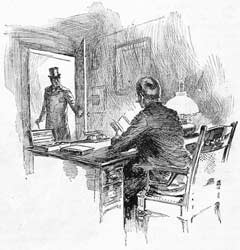






| Issue 12 : The Final Problem | ||||||
It is with a heavy heart that I take up my pen to write these the last words in which I shall ever record the singular gifts by which my friend Mr. Sherlock Holmes was distinguished. The Final Problem appeared in The Strand Magazine in December 1893, although the events narrated therein are supposed to take place in 1891. The Strand's reading public was outraged by what they considered the premature death of a beloved character. Over 20,000 people cancelled their subscriptions, and the magazine nearly went under. Forever after, The Strand's staff referred to Holmes's death as "the dreadful event." At his "death" in "The Final Problem," Holmes is younger than most people think, perhaps because Sidney Padgett's drawings give him an air of maturity. In "His Last Bow," which takes place in 1914 (and is told in the third person, not by Watson), Conan Doyle puts Holmes's age at about 60. Holmes could have been born in or around 1854. In "The Final Problem," therefore, he is not yet 40. ..."Study in Scarlet," up to the time of his interference in the matter of the "Naval Treaty".... A Study in Scarlet was the first Holmes and Watson story, a novelette published in Beeton's Christmas Annual in late 1887. "The Naval Treaty," published in The Strand in October and November, 1893, predated "The Final Problem" by a month. As far as I know, there have been only three accounts in the public press: that in the Journal de Genève on May 6th, 1891, the Reuter's dispatch in the English papers on May 7th, and finally the recent letters to which I have alluded. Reuters, opened in London in 1851 by a German immigrant named Paul Julius Reuter, began by reporting stock market quotations between European countries by telegraph. Where no telegraph lines had yet been strung, Reuter used carrier pigeons. Later, Reuters developed into a news dispatch service that used telegraph and radio to transmit the news from overseas to British newspapers. ...and I received two notes from Holmes, dated from Narbonne and from Nîmes.... Narbonne and Nîmes are French cities, both located in the south. |
||||||
Copyright ©
2006 Stanford University. All rights reserved. Stanford, CA 94305, (650)723-2300
l Terms
of Use

